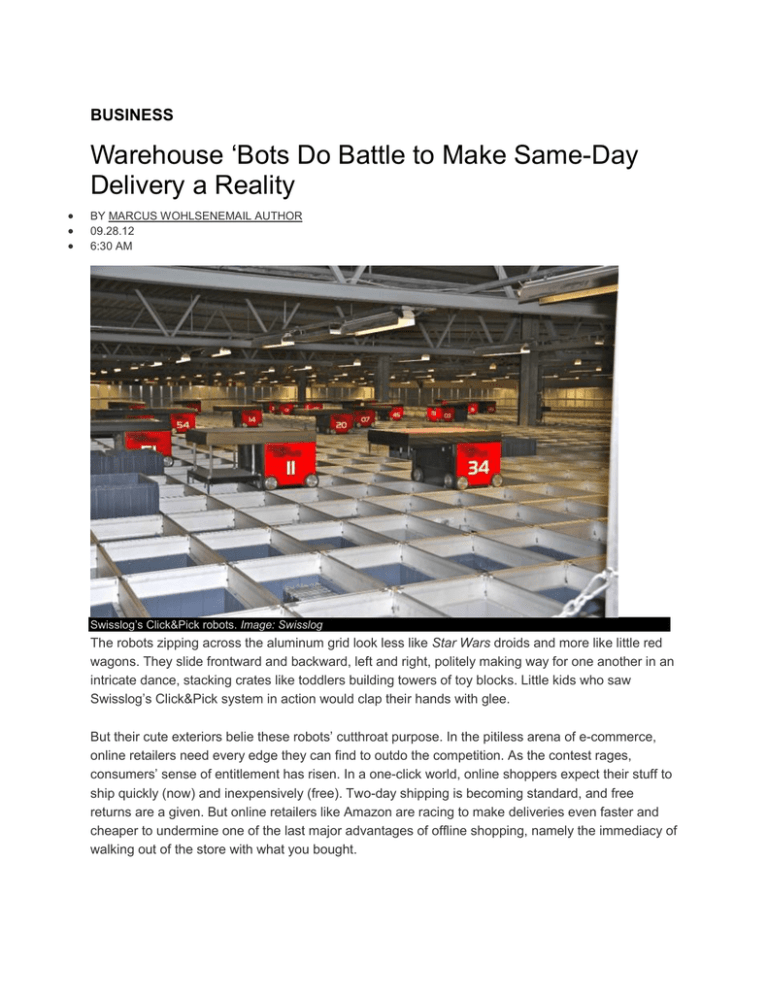Warehouse ‘Bots Do Battle to Make Same-Day Delivery a Reality BUSINESS
advertisement

BUSINESS Warehouse ‘Bots Do Battle to Make Same-Day Delivery a Reality BY MARCUS WOHLSENEMAIL AUTHOR 09.28.12 6:30 AM Swisslog’s Click&Pick robots. Image: Swisslog The robots zipping across the aluminum grid look less like Star Wars droids and more like little red wagons. They slide frontward and backward, left and right, politely making way for one another in an intricate dance, stacking crates like toddlers building towers of toy blocks. Little kids who saw Swisslog’s Click&Pick system in action would clap their hands with glee. But their cute exteriors belie these robots’ cutthroat purpose. In the pitiless arena of e-commerce, online retailers need every edge they can find to outdo the competition. As the contest rages, consumers’ sense of entitlement has risen. In a one-click world, online shoppers expect their stuff to ship quickly (now) and inexpensively (free). Two-day shipping is becoming standard, and free returns are a given. But online retailers like Amazon are racing to make deliveries even faster and cheaper to undermine one of the last major advantages of offline shopping, namely the immediacy of walking out of the store with what you bought. To meet that need for speed, robots are swarming in warehouses to eliminate the most inefficient variable in the e-commerce equation: us. At the moment, most of the massive distribution centers housing the goods you order online are still staffed by humans. And on the surface, people might seem perfectly well-suited to one of online retail’s core tasks: order fulfillment. The human brain and body working together would seem to come perfectly equipped to find that tube of toothpaste you ordered from Amazon, pull it off the warehouse shelf, box it up, and load it onto the truck. That process works fine for one order of one item. But in operations where thousands of orders can come in each hour, human networks don’t scale all that well. Essentially what large-scale e-commerce fulfillment operations create for their workers is the world’s most complicated trip to the grocery store. ‘Somebody has to go out there and basically go shopping for the consumer behind the scenes.’ — Bill Leber In traditional offline retail, distribution centers serve as way stations between wholesalers and consumers. Goods stored by the pallet and case are shipped to stores, where clerks break them up and put the individual items on shelves for customers to grab what they need. Online retail upends that traditional model by necessitating that someone — or something — act as a customer’s standin. “The process of shopping is pushed back into the distribution centers,” says Bill Leber, director of business development at Swisslog. “Somebody has to go out there and basically go shopping for the consumer behind the scenes.” With tens of thousands of items spread across tens of thousands of square feet at a typical distribution center, maintaining platoons of order fillers known as “pickers” gets costly and complicated. Not that pickers just wander up and down the aisles until they spot what they need. Even so-called “manual” systems rely on software as orders come in to point people along paths that, for instance, maximize the number of items they pick up along the way. Still, humans get tired. They move at different speeds. Some are stronger than others. We get distracted, cranky, lazy, and hurt. And you have to pay us. In that context, robots become increasingly attractive as the level of efficiency required to deliver on such logistically demanding promises as same-day delivery rises. Kris Bjorson, a supply chain consultant who heads the retail distribution group at Jones Lange LaSalle, says at that point only automated systems can ensure the necessary speed and accuracy. “You can’t keep on throwing labor at it,” he says. “It’s got to be right and it’s got to be on time. You don’t have that margin of (human) error.” That’s where picking systems such as those made by Swisslog come in. But Swisslog’s robots don’t simply replace humans roaming up and down aisles pulling items off of standard shelves. Swisslog’s Click&Pick setup radically transforms the entire look and feel of a warehouse interior. Rather than shelves, Click&Pick uses a three-dimensional grid system made of cubes stacked upand-down and side-to-side. Each cube contains a bin of equal size that holds the stock of a specific item, or what the industry calls a SKU. The wheeled robot pickers roam the grid’s top level, which also serves as the set of tracks on which the robots run. When an order comes in, a robot will slide to the specific column containing the bin that holds the item ordered and lower tethers that lift the bin to the top. If the bin holding the needed item is buried beneath several others, the robot will pull out the bins on top one by one and make a stack nearby until it reaches the container it needs. Next, the robot will deliver its cargo to a chute that sends the bin to a picking station staffed by a person. When the bin arrives, the human worker opens the lid, pulls out the cellphone, pair of jeans, bottle of shampoo or whatever else was ordered, and sends the item on its way to be boxed up and shipped. Leber says Swisslog’s system can work four to five times as quickly as human-powered operations of similar size. Click&Pick can fill 1,000 orders in an hour and an individual order in as fast as 20 minutes. And the system scales tidily. Have more SKUs? Get more robots. As for the robots themselves, they don’t need to sleep — at least not much. Each robot can run 22 out of 24 hours on a charge. When they need to recharge, Leber says the robots simply go and plug themselves in. For now, most of Swisslog’s e-commerce systems are in use in Europe, where the company started. In the U.S., Leber says Swisslog recently secured its first major customer: Chicago-based medical supplier Medline and its 125,000 SKUs. Kiva’s Magic Shelf. Image: Kiva Systems Meanwhile, Amazon has wagered on a very different-looking approach to automation. In March, the e-commerce pioneer announced its$775 million purchase of Kiva Systems, a Massachusetts company that makes what it calls the Magic Shelf for customers like Zappos, Crate and Barrel, and Diapers.com. Compared to Swisslog, a warehouse running Kiva would look like a more traditional operation, at least until the system is switched on and the shelves start moving (video here). The shelves themselves aren’t robotic. Instead, they’re lifted from below by squat, orange selfdriving dollies that resemble oversize computer mice. These fetch the needed shelves and bring them to stationary humans manning picking stations, where lights and laser pointers guide them directly to the shelf and bin containing the item ordered. “One day is going to be as much as anybody will wait for an online order, and everyone will expect free shipping,” says Peter Blair, Kiva’s senior director of marketing. “You don’t pay an entrance fee to walk into a store.” Blair says that over time, the Kiva system’s hive mind will learn which items get ordered more frequently and start placing those shelves closer to the picking stations. This constant reshuffling that keeps inventory in motion to maximize accessibility yields yet another efficiency that would push the limits of humans trying to mimic such complex choreography. Not that e-commerce operations don’t try to get their human workers to behave like automatons. In one of the great recent feats of investigative journalism, Mother Jones human rights reporter Mac McClelland worked as a picker at an unnamed major e-commerce distribution center and found brutal conditions in which workers were expected to act as much like robots as possible. Directed by the same kinds of efficiency algorithms that robots can handle with ease, workers face timed bathroom breaks, mandatory overtime, and backbreaking quotas enforced through a totalitarian demerit system that pushes people to the point of getting hurt for fear of losing their $11-an-hour gig as a perma-temp with no benefits. “They are basically being treated as if they don’t have injurable body parts,” McClelland says. “There’s nothing human about the conditions in those warehouses as it is.” McClelland’s story leaves you with a sense of outrage that corporate and government policies allow for the conditions she describes. But you’re also left mystified. Why would most e-commerce operations still rely on human-powered systems when order-picking seems exactly like the kind of rote, math-driven task that robots are ideally suited to perform? Why try to turn humans into drones, when you can just use drones? ‘Until Amazon’s purchase of Kiva, anyone who had visited an Amazon facility was struck by how manual their processes were.’ — Fiona Dias It comes down to cost. Fiona Dias is the chief strategy officer atShopRunner, a members-only service that offers free two-day shipping from dozens of retailers. She says the issue of humans versus robots comes down to millions it costs to upgrade to robots compared to what’s already working. “Until Amazon’s purchase of Kiva, anyone who had visited an Amazon facility was struck by how manual their processes were,” Dias wrote in an e-mail. “In other words, Amazon has been able to build a massive business relying on humans.” For most companies, she says robots are still costprohibitive capital investments that would require major overhauls of operations and facilities without showing a return on investment for several years. (The smallest Swisslog and Kiva systems both start at $1 million.) “We can count on having many, many people in warehouses for a long time,” Dias says. But Bjorson says online retailers will reach a tipping point where they will have to make the choice to “flip the switch.” That point is starting to arrive for the most entrenched e-commerce players such as Amaazon, which is embarking on a billion-dollar effort to build warehouses closer to where people live. For the biggest online retailers, the combination of proximity and robot-powered automation hold the key to meeting the exacting efficiencies that would make same-day delivery not just possible but profitable. In the future, the better bot may also be what sets apart the retailers that survive the twin onslaughts of ever increasing competition and consumers’ insatiable desire to get their orders faster. “These companies understand what that one second means. And they can quantify what that one second means,” Bjorson says. “This is sort of the last frontier.”



